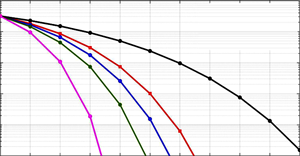Hybrid spectrum sensing enhancement for cognitive radio in 6G radio system
DOI:
https://doi.org/10.3103/S0735272723050023Keywords:
6G, Spectrum Sensing, Hybrid Algorithm, MF, Energy DetectionAbstract
This article highlights the potential advantages of the proposed hybrid algorithm for 6G. The algorithm’s adaptability addresses the dynamic spectral characteristics of 6G environments, enabling a seamless transition between different spectral conditions. The hybrid approach holds promise for enhancing spectrum utilization, reducing interference, and optimizing overall communication system performance. As 6G technology evolves, the integration of energy detection and cyclostationary spectrum sensing through the hybrid algorithm offers a glimpse into innovative techniques that can shape the future of wireless communication, unlocking the potential for enhanced connectivity, efficiency, and user experience. Several parameters such as the probability of detection (Pd), probability of false alarm (Pfa), bit error rate (BER), and power spectral density (PSD) are compared and analyzed with the conventional spectrum sensing algorithms. We see that the proposed hybrid algorithms obtain a substantial detection performance at the low signal-to-noise ratio (SNR).
References
- Q. Wu, W. Wang, Z. Li, B. Zhou, Y. Huang, X. Wang, “SpectrumChain: a disruptive dynamic spectrum-sharing framework for 6G,” Sci. China Inf. Sci., vol. 66, no. 3, p. 130302, 2023, doi: https://doi.org/10.1007/s11432-022-3692-5.
- A. Kumar, M. A. Albreem, M. Gupta, M. H. Alsharif, S. Kim, “Future 5G network based smart hospitals: Hybrid detection technique for latency improvement,” IEEE Access, vol. 8, pp. 153240–153249, 2020, doi: https://doi.org/10.1109/ACCESS.2020.3017625.
- A. Ivanov, K. Tonchev, V. Poulkov, A. Manolova, “Probabilistic spectrum sensing based on feature detection for 6G cognitive radio: A survey,” IEEE Access, vol. 9, pp. 116994–117026, 2021, doi: https://doi.org/10.1109/ACCESS.2021.3106235.
- A. Kumar, J. Venkatesh, N. Gaur, M. H. Alsharif, A. Jahid, K. Raju, “Analysis of hybrid spectrum sensing for 5G and 6G waveforms,” Electronics, vol. 12, no. 1, p. 138, 2022, doi: https://doi.org/10.3390/electronics12010138.
- P. Deepanramkumar, N. Jaisankar, “BlockCRN-IoCV: Secure spectrum access and beamforming for defense against attacks in mmWave massive MIMO CRN in 6G Internet of connected vehicles,” IEEE Access, vol. 10, pp. 74220–74243, 2022, doi: https://doi.org/10.1109/ACCESS.2022.3187745.
- Z. Wei et al., “Integrated sensing and communication signals toward 5G-A and 6G: A survey,” IEEE Internet Things J., vol. 10, no. 13, pp. 11068–11092, 2023, doi: https://doi.org/10.1109/JIOT.2023.3235618.
- C. Chaccour, M. N. Soorki, W. Saad, M. Bennis, P. Popovski, M. Debbah, “Seven defining features of terahertz (THz) wireless systems: A fellowship of communication and sensing,” IEEE Commun. Surv. Tutorials, vol. 24, no. 2, pp. 967–993, 2022, doi: https://doi.org/10.1109/COMST.2022.3143454.
- K. Kockaya, I. Develi, “Spectrum sensing in cognitive radio networks: threshold optimization and analysis,” EURASIP J. Wirel. Commun. Netw., vol. 2020, no. 1, p. 255, 2020, doi: https://doi.org/10.1186/s13638-020-01870-7.
- A. Kumar, M. K. Sharma, K. Sengar, S. Kumar, “NOMA based CR for QAM-64 and QAM-256,” Egypt. Informatics J., vol. 21, no. 2, pp. 67–71, 2020, doi: https://doi.org/10.1016/j.eij.2019.10.004.
- A. Kumar, J. Venkatesh, N. Gaur, M. H. Alsharif, P. Uthansakul, M. Uthansakul, “Cyclostationary and energy detection spectrum sensing beyond 5G waveforms,” Electron. Res. Arch., vol. 31, no. 6, pp. 3400–3416, 2023, doi: https://doi.org/10.3934/era.2023172.
- A. Kumar, P. NandhaKumar, “OFDM system with cyclostationary feature detection spectrum sensing,” ICT Express, vol. 5, no. 1, pp. 21–25, 2019, doi: https://doi.org/10.1016/j.icte.2018.01.007.
- A. Martian, M. J. A. Al Sammarraie, C. Vlădeanu, D. C. Popescu, “Three-event energy detection with adaptive threshold for spectrum sensing in cognitive radio systems,” Sensors, vol. 20, no. 13, p. 3614, 2020, doi: https://doi.org/10.3390/s20133614.
- J. Lorincz, I. Ramljak, D. Begusic, “Algorithm for evaluating energy detection spectrum sensing performance of cognitive radio MIMO-OFDM systems,” Sensors, vol. 21, no. 20, p. 6881, 2021, doi: https://doi.org/10.3390/s21206881.
- M. Chaitra, S. Sinha, “Spectrum sensing in cognitive radio using energy detection: Comprehensive analysis,” in Proceedings of the Fist International Conference on Advanced Scientific Innovation in Science, Engineering and Technology, ICASISET 2020, 16-17 May 2020, Chennai, India, 2021, doi: https://doi.org/10.4108/eai.16-5-2020.2303966.
- M. K. Giri, S. Majumder, “Cooperative spectrum sensing using extreme learning machines for cognitive radio networks,” IETE Tech. Rev., vol. 39, no. 3, pp. 698–712, 2022, doi: https://doi.org/10.1080/02564602.2021.1896979.
- A. Kumar, “PAPR reduction of FBMC using hybrid and k-hybrid techniques,” Radioelectron. Commun. Syst., vol. 62, no. 10, pp. 501–509, 2019, doi: https://doi.org/10.3103/S0735272719100029.
- X. Fang, W. Feng, Y. Chen, N. Ge, Y. Zhang, “Joint communication and sensing toward 6G: Models and potential of using MIMO,” IEEE Internet Things J., vol. 10, no. 5, pp. 4093–4116, 2023, doi: https://doi.org/10.1109/JIOT.2022.3227215.
- A. Kumar, H. Rathore, “Modified DSLM technique for PAPR reduction in FBMC system,” Radioelectron. Commun. Syst., vol. 62, no. 8, pp. 416–421, 2019, doi: https://doi.org/10.3103/S0735272719080053.


